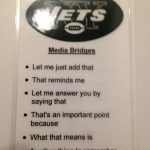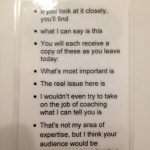Ever since I was a kid, I was fascinated by impossible problems or lost causes. Over the last 20 years, I’ve developed a theory on how best to tackle such issues.
First, you need to view the impossible-to-solve problem as a giant cube stuck in the middle of a long trail, with your desired result at the end of the path. Pushing or pulling the cube is a waste of time, because it’s simply too big and heavy.
But, if you start methodically chipping away at the cube’s corners, you can slowly turn that cube into a giant sphere. Chip away enough and that sphere will start rolling after a good push. Eventually the now-rolling sphere will build momentum and hit something along the trail, causing the once immovable cube to break into pieces. And, poof! The once-daunting problem is no more.
The biggest mistake companies and agencies make is failing to chip away at the corners of a big, long-term problem. Instead, they take one big whack to try and solve a problem in one week and then give up, or they simply refuse to try at all as the problem looks too daunting. As a result, the problem remains unchanged, serving as an anchor stopping you from achieving your long-term goals.
To solve big problems, start by grabbing hold of the low hanging fruit. Here’s an example. Let’s say an Emergency Department in a city with multiple hospitals has a particularly bad reputation among patients and first responders. Because of this, ambulance crews choose to take their patients to other nearby facilities when given the option.
That reputation, earned or not, is costing the hospital a lot of money because of fewer admissions. Hospital administrators notice this kind of thing, especially new administrators as they are brought in to a facility to fix problems. So the new hospital administrator meets with the local agency Chiefs and says on a Monday that starting Tuesday, all the problems that occurred in the past will be fixed.
Will the ambulances all of a sudden start coming back on Tuesday? Of course not.
The ambulance crews want to see and experience the change before they’ll believe what the facility says. But it’s a catch-22 since the crews no longer stop by the facility and they’re unlikely to see if the changes promised have actually occurred.
The Emergency Department has to take numerous steps to win back first responders. The first question is to identify changes that first responders are most likely to notice and appreciate.
Is there a comfortable area for ambulance crews to do their paperwork? Are crews fed by the hospital, given snacks or cafeteria discounts? Do facility staff treat crews as peers rather than as a FedEx Delivery person? How quick and easy is the transition from medic to nurse allowing the crew to get back in service?
If the Emergency Department puts actions behind their words, and demonstrate changes that first responders can see, in time the ambulance crews will not only come back but would likely choose that facility over others.
The same principle works in reverse. Why should a community or care facility support an ambulance provider and their crews that operate with arrogance? You don’t win community support by showing up at occasional council meetings.
The key is tackling the obstacle slowly and methodically, chipping away at the problem. To do that, you need to know the real problem. In most cases, it’s multiple problems that all fit under one broad umbrella that is called reputation.
Here are some suggestions on how to start solving impossible problems:
- Start by making a list of the perceived problems. The more problems on your list, the more things you can solve… and in time show that you resolved.
- After making your list, put the problems that are easiest (and cheapest) to solve at the top of your list. Those are the problems that you start chipping away at first.
- Keep working the easiest to solve problem on your list, which will keep getting shorter as you cross items off. You’ll likely be surprised to find that the next problem on your list is easier to solve than if you had tried to solve that problem first.
- Celebrate each solved problem internally among your staff, and find a way to announce change publicly. For example, in the Emergency Department example, if the Hospital sets aside space for ambulance crews, they should try to make a news story out of it by hosting a ribbon cutting where providers are invited, etc. They don’t need to say WHY they created the special area or point out the problem to those who didn’t already know about it. They just should announce the area and highlight the partnerships and how much respect they have for the ambulance crews, hence why they found the space.
It’s also worth noting that you’ll likely find that many of the biggest problems are perception oriented, rather than service oriented. Writing a check alone won’t solve all problems. That’s where a good, long-term public relations plan is essential. Public Relations isn’t just about reporters, it’s also about communicating with your customers, peers and your own employees and co-workers.
One of the best ways to help people to change their mindset is to change what they see every day. For example, when it comes to management showing its own employees that they care, the first step to getting employees to notice the efforts is to put a new color of paint on station walls or by rearranging/adding new furniture. Now that you have their physical attention, they’ll be more receptive to what you say and how you act. Maybe I’ll expand on this concept in a future column.
To recap, don’t give up on immovable problems. Ignoring problems only make them harder and more expensive (in cash and time) to overcome. By chipping away at the easy to solve problems and complaints, you’ll help change the reputation and help you achieve your goals.


